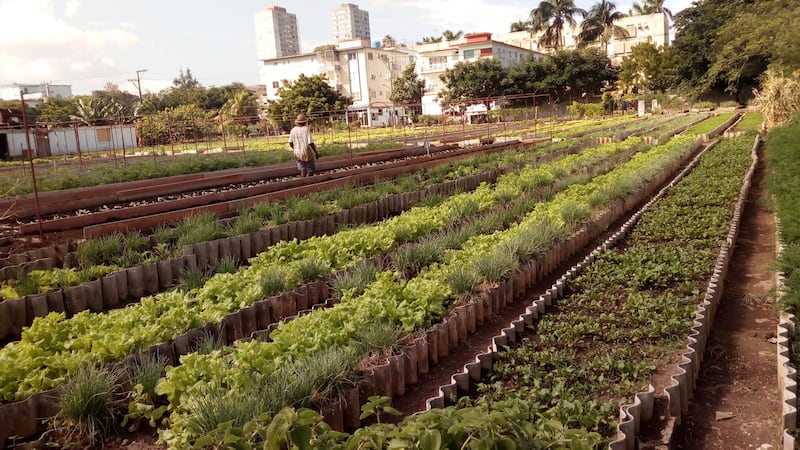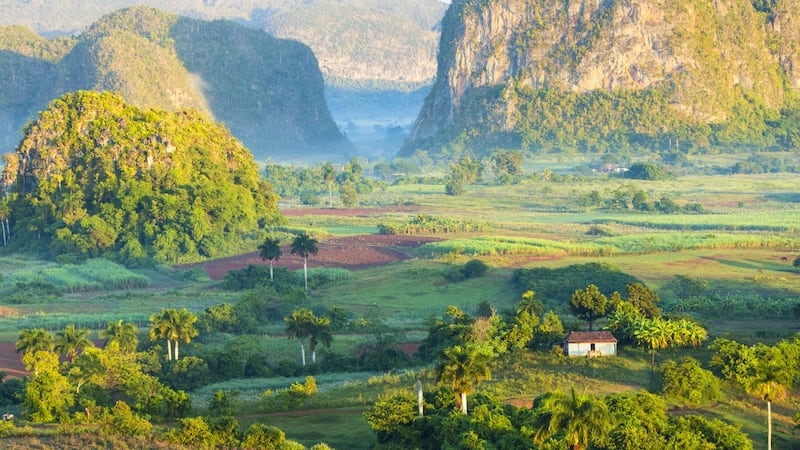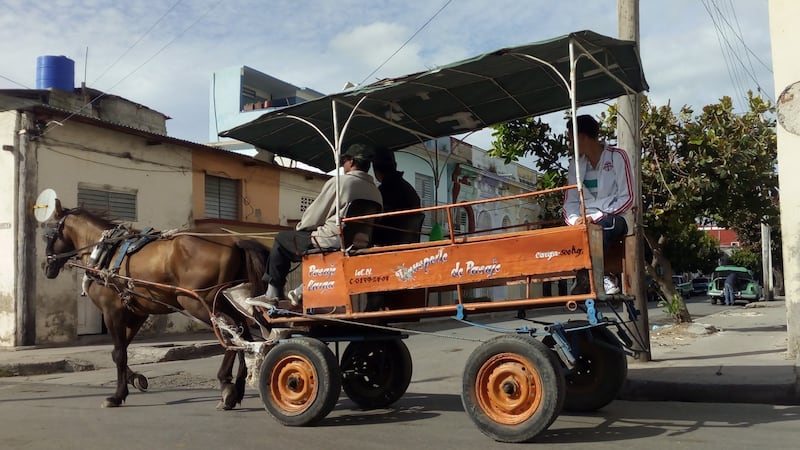By not participating in the ravenous capitalism of the second half of the 20th century, Cuba avoided much of the environmental degradation seen elsewhere, which prompts the question: could it be the ideal eco-tourism destination, where the concrete spread of modernity has not yet smothered all before it?
I spent a month earlier this year travelling around the island and found a wealth of Unesco Biosphere Reserves, pristine tropical rainforest, mangrove forests and the world's second-largest coral reef, but it was Cuba's sustainability in terms of food production and focus on local grassroots engagement that really made its ecotourism credentials shine.
Every town, village and city has co-operatively-owned vegetable plots set up to ensure sustainable food supply in the event of an invasion by the US. After the dissolution of the Soviet Union in 1990, when Russian fertilisers were no longer accessible, these vegetable plots turned exclusively organic. The country now has more urban vegetable-growing initiatives than anywhere on earth, each constantly consulting with agricultural advisers to improve techniques and yield. The salads you'll be served anywhere will undoubtedly be organic – though this is not the case for other field-based vegetables, such as sweet potatoes or onions.
0 of 3

To witness an area in which everything is organic, it is worth taking a bus or collective taxi three hours west from Havana to Viñales, a bucolic valley encircled by mountains and pockmarked by spectacular dome-like limestone outcrops (mogotes) which has Unesco World Heritage status for its farming techniques that are unchanged for several centuries. Unesco ensures that all farming in this region, which is mostly tobacco production, is done without machinery or chemicals, and so you'll see oxen ploughing the land and farmers making herbal concoctions of leaves and roots to spray on plants as natural pesticides.
From the traditional rocking-chair-and-veranda homes of Viñales there are numerous hiking trails reaching out into the national parks and hills surrounding the town, most are also suitable for cycling and horse riding. A day spent walking through a landscape in which farmers are growing coffee, corn, rice, tobacco and sweet potato all without chemicals or tractors is both invigorating and relaxing. Horse and carts are still used as taxis throughout the valley and animal manure is scrupulously collected for later enrichment of the land.
Ecological ideal
For an even more idyllic iteration of an ecological ideal, spend a night or two in Las Terrazas, a tiny sustainable lakeside village that stems from a visionary campaign to tackle soil erosion and deforestation in the 1960s by sending citizens up into the mountains to terrace the slopes and plant indigenous trees to restore a land that had been denuded and degraded by French-owned coffee estates. In 1968 the government conceived the idea of building an eco-village for local artists, musicians and botanists, and today, this self-supporting, sustainable settlement is a beacon of enlightened energy use, harmonious building and small-scale organic farming. It has possibly the finest organic, vegetarian restaurant in Cuba, El Romero, which uses solar energy to cook food and keeps its own bees.
The hiking trails through the, now thriving, mountain forests surrounding Las Terrazas are a wonderland of indigenous plants and countless species of birds. These, as with almost all trails throughout Cuba are not signposted, as the government is keen that people hire a local guide to stimulate the economy and to ensure genuine grassroots community tourism. But since there are no venomous or poisonous animals in Cuba, and people everywhere are so extraordinarily welcoming, there is nothing stopping you heading off into the hills for multi-day walks, especially if you have a smattering of Spanish to help re-orientate yourself when lost.

It’s worth mentioning that neither Viñales nor Las Terrazas are remote marginal destinations for eco-buffs, they are actually the two prime tourist spots nearest to Havana. Cuba is making significant efforts to present itself as a primarily green tourism destination, with 10% of its entire landmass now under environmental protection. The militaristic fervour with which they guard their preserved land can make it hard to access some of their more spectacular wildernesses, but compromises are being reached to allow sensitive tourism in even the most fragile wetlands, mangrove forests, coral reefs and jungles.
The state-run tourism body, Ecotour, has now initiated tours to all six of Cuba’s Unesco-designated biosphere reserves. These include the mountain reserve of Sierra del Rosario adjoining Las Terrazas, which has over 100 bird species, from humming birds to mockingbirds and nightingales.
Protected region
Southeast of this reserve is the Ciénaga de Zapata Biosphere Reserve, another protected region of mountain fen, Caribbean coast and swampy wilderness, which shelter more than 175 species of birds, and scores of rare creatures, like the great flamingo and the Cuban crocodile (dangerous, perhaps, but not poisonous).
Most of the 800,000 tourists who visit this vast southern coastal province of only 9,000 inhabitants are lured to the resorts of Boca de Guamá and Playa Girón, but an increasing few are opting to experience its rare stretches of pristine ecosytem on ecological walking tours.
One final reserve worth mentioning is the Cuchillas del Toa Biosphere, about 15 hours east. The reserve is inside the Alexander de Humboldt National Park, which itself is a Unesco World Heritage Site, with misty, forested mountains, fog forests and alluvial plains, running down to mangroves and coral reefs. This area has over 900 endemic species.
But, it wasn't any of these small-scale, nature tourism experiences, or any of Cuba's other three biosphere reserves, or its two natural Unesco World Heritage Sites, or six Ramsar Convention Sites that really enthused me, rather it was five nights I spent in a community-based tourism initiative on a 800-hectare organic farm between the architecturally-alluring Renaissance town of Remedios and the sleepy farming settlement of Morón. Here at La Picadora 80 families (227 villagers) who collectively own and run the farm have converted three of their traditional wooden cottages into tourist accommodation.
A room and three delicious organic meals is €25 per day, with all food grown on the farm, from rice to coconut to pork. The community are keen to involve visitors in daily agricultural life as much as they wish to; from churning butter, to moulding adobe blocks, mixing worm compost, planting rice, harvesting coconuts, growing coffee and ploughing with oxen.
Community tourism
La Picadora offers as genuine an experience of community tourism as I’ve encountered and an insight into how the Cuban economic model can still work in particular circumstances. The farmers here collectively own their two trucks, three tractors and one 4x4, and receive about €22 per month as a salary (depending on what personal side-produce they might also be growing).
While this economic model may no longer be tenable in a tourist town, where waiters earn double that in tips in one night, in regions like La Picadora, where all food can be produced on the farm, from sugar to grain to milk and meat, and the government offers free education, free healthcare (with a particular emphasis on preventative medicine) and practically free entertainment in the form of subsidised concerts, ballet, sports and movies, the system still works. Locals assured me their lives were fulfilling and enjoyable, and the community seemed to be thriving. The co-operative members united to build houses for each other and the rather ramshackle transport system of bus-trucks and shared taxis mean that they do not need cars.

It was such an enriching experience for me to be able to spend five days on my rocking chair on the veranda getting to grips with this community, hearing stories from the old folk who remember their fathers slaving on the old sugar plantation before the land was divided among the people after the revolution in 1959.
Clearly, there are still many elements of Cuba that are not yet "green". The American economic blockade has forced them to continue using ancient trucks and cars that billow black fumes because of the low-quality diesel they are forced to import, and the majority of their tourism is old-style, resource-hungry, resort tourism which exerts a heavy toll on the landscape. Their industries are outdated and energy-guzzling; there is virtually no waste recycling and air quality in the cities is dire. But all that said, Cuba's unique Rip Van Winkle experience during the 20th century of enforced isolation and stagnation have left us with a socialist republic that still cherishes aspects of nature and of traditional farming life that have been lost elsewhere.
CUBA: HOW TO
How to Get There
Air France/KLM have consistently provided the most direct and cheapest flights to Cuba via Paris from around €750 return.
When to Go
Cuba has a warm tropical climate with two distinct seasons: December to May has mostly bright, dry, sunny days, with the wet season beginning in June and leading to potential hurricanes from August to October.
Where to stay
Cuba's primary accommodation outside resorts are Casa Particulares (homestays) which ensure citizens benefits directly from tourism.
Las Terrazas has a famous eco hotel, Hotel Moka, hotelmoka-lasterrazas.com built by the brother of one of its greatest revolutionaries, Camilo Cienfuegos, €140, though I'd recommend staying in a private farmhouse Villa Duque 5km away, where all food will be grown on the farm, €20.
Viñales: Villa Cirilo y Geilyn, Calle Salvador Cisnero, +53 5303 0648 … or Villas Dos Marias, Salvador Cisneros, villaddosmarias@nauta.cu, +53 5310 3624. The former is the home of Geilyn, a charming dentist assistant who has a separate room with its own entrance, the latter has two rooms owned by a lecturer in geological excavation, named Yandy, who has fluent English and is also a guide and taxi. They cost about €13 per night.
La Picadora Cooperative Organic Farm: Carretera Mayajigua, Yaguajay, Sancti Spíritus, +53 5230 1043, la.picadora.cuba@gmail.com













